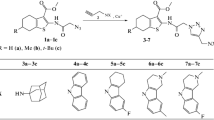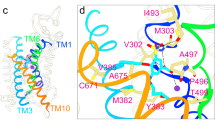Abstract
On the basis of our findings with diphenylamine-2-carboxylate [5] we have searched for compounds which possess an even higher affinity for the Cl−-channels in the basolateral membrane of the thick ascending limb of the loop of Henle. To quantitiy the inhibitory potency, we performed measurements of the equivalent short circuit current, corresponding to the secondary active transport of Cl− [8] and measurements of the voltage across the basolateral membrane. A survey of 219 compounds reveals that relatively simple modifications in the structure of diphenylamine-2-carboxylate led to very potent blockers such as 5-nitro-2-(3-phenylpropylamino)-benzoate which inhibits the short circuit current half maximally (IC50) at 8·10−8 mol/l. A comparison of the structural formula and the respective IC50 values leads to several empirical conclusions: 1. The potent compounds are lipophilic due to the apolar residue (e.g. phenyl- or cycloalkyl group). Replacing this part of the molecule by an aliphatic chain (up to 4 C-atoms) leads to inactive compounds. 2. Most of the inhibitors are secondary amines. Linking other than with-NH- between the phenyl ring and the benzoic acid results in inactive compounds. Tertiary amines, such as in case of 2-(N,N-diphenylamine) benzoic acid or N-methylphenylaminebenzoic acid are poorly active. 3. The carboxylate group of the benzoate moiety must be in ortho position to the amino group. 4. Introduction of substituents into the benzoate moiety e.g.-NO2 (in meta position to the carboxylate group), or by-Cl (in para position to the carboxylate group) results in an increase of inhibitory potency. 5. A-CH2-,-C2H4-,-C3H6-) spacer between the amino bridge and the phenyl ring increases the affinity for the Cl−-channel by several orders of magnitude. The above described structure activity relationship renders it likely that these chloride channel blockers possess several sites of interaction: The negatively charged carboxylate group, the secondary amine group which probably carries a positive partial charge, and for the very potent agents (nos. 130, 143, 144, and 145) an additional negative partial charge at the respective-Cl or-NO2 substituent. Finally, also an apolar interaction with an cycloalkyl or cycloaryl residue seems to be required, and this site of interaction has a defined spacing from the secondary amino nitrogen.
Similar content being viewed by others
References
Atwater I, Rosario L, Rojas E (1983) Properties of the Ca-activated K+ channel in pancreatic β-cells. Cell Calcium 4:451–461
Cabantchik ZI, Rothstein A (1972) The nature of the membrane sites controlling anion permeability of human red blood cells as determined by studies with disulfonic stilbene derivatives. J Membr Biol 10:311–330
Cousin J-L, Motais R (1982) Inhibition of anion transport in the red blood cell by anionic amphiphilic compounds. I. Determination of the flufenamate-binding site by proteolytic dissection of the band 3 protein. Biochim Biophys Acta 687:147–155
Cousin J-L, Motais R (1982) Properties of anion transport in the red blood cell by anionic amphiphilic compounds. II. Chemical properties of the flufenamate-binding site on the band 3 protein. Biochim Biophys Acta 687:156–164
Di Stefano A, Wittner M, Schlatter E, Lang HJ, Engler H, Greger R (1985) Diphenylamine-2-carboxylate, a blocker of the Cl−-conductive pathway in Cl−-transporting epithelia. Pflügers Arch 405 (Suppl 1):S95-S100
Greger R (1981) Cation selectivity of the isolated perfused cortical thick ascending limb of Henle's loop of rabbit kidney. Pflügers Arch 390:30–37
Greger R (1984) The Na+/K+/2Cl− system in the diluting segment of rabbit kidney. In: Ion transport processes in apical membranes of epithelia. Fed Proc 43 (10):2473–2487
Greger R (1985) Ion transport mechanisms in thick ascending limb of Henle's loop of mammalian nephron. Phys Rev 65 (3):760–797
Greger R, Gögelein H (1985) Patch clamp analysis of the ionic conductances in the rectal gland ofSqualus acanthias. MDIBL Bull 25:116–119
Greger R, Schlatter E (1983) Properties of the lumen membrane of the cortical thick ascending limb of Henle's loop of rabbit kidney. Pflügers Arch 396:315–324
Greger R, Schlatter E (1983) Properties of the basolateral membrane of the cortical thick ascending limb of Henle's loop of rabbit kidney. A model for secondary active chloride transport. Pflügers Arch 396:325–334
Greger R, Schlatter E (1983) Cellular mechanism of the action of loop diuretics on the thick ascending limb of Henle's loop. Klin Wochenschr 61:1016–1027
Greger R, Oberleithner H, Schlatter E, Cassola AC, Weidtke C (1983) Chloride activity in cells of isolated perfused cortical thick ascending limbs of rabbit kidney. Pflügers Arch 399:29–34
Greger R, Weidtke C, Schlatter E, Wittner M, Gebler B (1984) Potassium activity in cells of isolated perfused cortical thick ascending limbs of rabbit kidney. Pflügers Arch 401:52–57
Oberleithner H, Ritter M, Lang G, Guggino W (1983) Anthracene-9-carboxylic acid inhibits renal chloride reabsorption. Pflügers Arch 398:172–174
Palade PT, Barchi RL (1977) On the inhibition of muscle membrane chloride conductance by aromatic carboxylic acids. J Gen Physiol 69:879–896
Schlatter E, Greger R, Weidtke C (1983) Effect of “high ceiling” diuretics on active salt transport in the cortical thick ascending limb of Henle's loop of rabbit kidney. Correlation of chemical structure and inhibitory potency. Pflügers Arch 396:210–217
Wittner M, Schlatter E, Delarge J, Greger R (1986) Torasemide, a diuretic blocking both, the Na+2Cl−K+ carrier and Cl−-channels. Kidney Int (in press)
Author information
Authors and Affiliations
Additional information
Supported by Deutsche Forschungsgemeinschaft Gr 480/6
Rights and permissions
About this article
Cite this article
Wangemann, P., Wittner, M., Di Stefano, A. et al. Cl−-channel blockers in the thick ascending limb of the loop of Henle Structure activity relationship. Pflugers Arch. 407 (Suppl 2), S128–S141 (1986). https://doi.org/10.1007/BF00584942
Received:
Accepted:
Issue Date:
DOI: https://doi.org/10.1007/BF00584942




